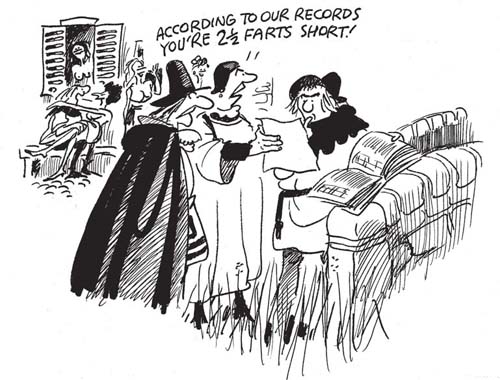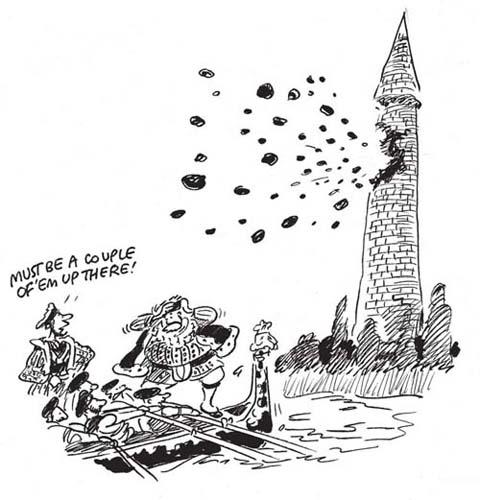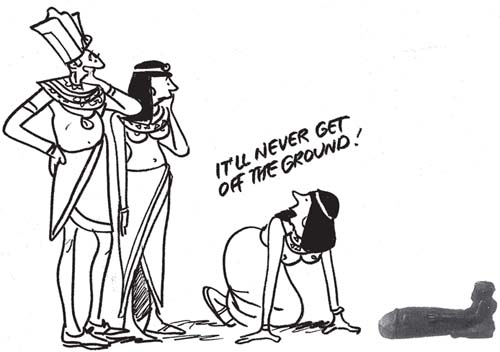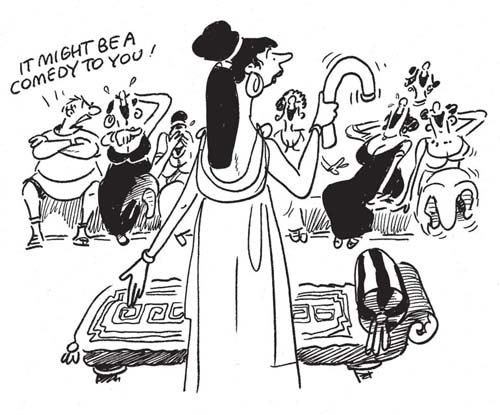Disgraceful Archaeology (7 page)
Read Disgraceful Archaeology Online
Authors: Paul Bahn


29
The deities of many ancient peoples â Greeks, Romans, Egyptians and others â were restricted in their powers and functions. They were not able to cure all diseases, only particular kinds, each god being a specialist; consequently, each was supposed to take charge of a section of the human body. Hence, Bel-Phegor (see below, p. 75) was doubtless the deity to whom the devotee resorted for the alleviation of ailments connected with the rectum and belly â the worshipper would offer him the sacrifice of flatulence and excrement, testimonies of the good health for which gratitude was due to the deity. In medieval times, they were replaced by Saints â for example, Saint Erasmus was in charge of âthe belly with the entrayles', while Saint Phiacre was invoked to relieve people of âthe phy or emeroids, of those especially which grow in the fundament'.
Although the adoration of Flatulence cannot be found among the Chinese, religious customs equally revolting have been ascribed to them. Mohammedans who travelled through China in the ninth century reported that âthe Chinese are addicted to the abominable vice of Sodomy, and the filthy practice of it they number among the indifferent things they perform in honor of their idols'.
There is a story that Henry VIII of England enjoyed rhyming, and one day, while travelling on the river from Westminster to Greenwich to visit âa fair lady whom he loved and lodged in the tower of the park', he challenged Sir Andrew Flamock to compose with him. The King wrote:
Within this tower
There lieth a flower
That hath my heart.
Exactly what Sir Andrew replied has been kept discreetly hidden, but a version of his answer appeared in one of the worst plays of almost any century:
Within this hour
She pist full sower
And let a fart
Legend has it that the monarch was not amused and bid Flamock âavant varlet and begone' (
30
).

30
Male sexual organs are depicted in Moche pottery, showing testicles and penis, with the foreskin folded back showing the gland. These were drunk from, thus converting them into a sort of instrument of artificial fellatio.
One Moche pot shows a male anally penetrating a female asleep in bed between her parents.
In Moche pottery, 95 percent of the sex depicted seems to be anal, though heterosexual; the fellatio is all heterosexual, but there is no cunnilingus. Whether engaged in vaginal, anal or oral intercourse, the male face always remains totally impassive.
Musical instruments can often be seen in an erotic context, especially in Graeco-Roman figurines where the man’s phallus is either part of the musical instrument or used for playing it.
The Romans had ‘willy pots’ — the Roman site of Stonea Grange in Britain produced a pot with no less than 21 phalli shown on it. In fact the Romans were obsessed with phalli — little boys wore them round the neck, there were phalli hung up in Pompeian houses with bells on them and wings; they had phalli outside the doors, on street corners, etc. Many other ancient cultures, such as the Egyptian, also employed erotic amulets with huge phalli.
The House of the Vettii at Pompeii has a fountain in the form of an ithyphallic figure, with its phallus serving as a waterspout; and a painting of Priapus weighing his enormous penis. Other erotic scenes are painted in a small room by the kitchen.
The ancient Greek visual arts show that they admired a thin, short penis, terminating in a long pointed foreskin; the small
penis goes with a scrotum of normal size, while the erect penis is depicted with normal proportions.

31
Greek artists often emphasised the small pointed penis of Herakles as opposed to the stubby and circumcised genitals of barbarian attendants. Aristotle’s explanation for this predilection for small genitals was that the small penis is more fertile than the large one, because the seed has a shorter distance to travel through it, and so doesn’t cool off so much.
The Greek taste for dainty, pointed penises led to a custom of infibulation — to prevent the foreskin from becoming damaged while exercising in the nude, young athletes tied it down over the glans with a leather string, sometimes tucking up the penis with the same string as well. The knot was called ‘
kynodesme
’ or’dog tie’, and functioned something like a jock strap.
One Greek vase shows a musician, whose hands are fully occupied with the double pipe, having a spontaneous ejaculation, while a bewildered bee dodges the bombardment.

32
There is also an ancient Greek depiction of a hairy satyr masturbating while pushing a penis-substitute into his own anus.
Egypt’s king Menaphta, who defeated the Libyans in 1300 BC, collected the penises of his slain enemies as battle trophies.
During the summer of 415 BC, Athens was shaken by a scandal. A group of conspirators, moving through the city under cover of night, mutilated the ‘herms’, statues of the god Hermes — these statues were plain rectangular pillars, with a head and erect male genitals. Almost all of them were castrated — a highly symbolic crime. There were hundreds of them, in private and public places. It was never discovered who did the terrible deed (
32
).
In ancient Greek comedy there are a number of jokes about the use, by women of a respectable class, of self-satisfiers or dildos,
made of leather. They were known as
olisboi
, derived from a verb meaning to glide or slip. A few vases show naked women using them in fairly fantastic ways — they could be prostitutes, or simply imaginary scenes.
The island of Lesbos, to the ancient Greeks, was not associated with female homoerotism but with fellatio — the verbs ‘
lesbiazo
’ and ‘
lesbizo
’ refer to that practice. The ancient Greek word for ‘lesbian woman’ in our sense was ‘
tribas
’, from a root meaning ‘rub’.
In an old Greek comedy, one woman suggests that the dildo resembles the real organ as the moon resembles the sun it looks the same but lacks heat (
33
).

33
In the Moche pottery of prehistoric Peru, males sometimes caress women’s chins, and occasionally touch their breasts, but there are no cases of these being sucked or kissed. In fact, kissing of any kind is only depicted between women and corpses.
The Egyptians used the word for female private parts as a deprecation a woman who had played a dirty trick on someone was called a ‘
kat tahut’ — ‘kat’
means vulva, while
‘tahut’
probably means prostitute. Vulvas were carved on pillars to call people cowards.
The Egyptians were very amused by female flashers one tomb inscription tells the story of Re, chairman of the council of gods, who was sulking after being insulted by a rival. He only cheered up after his daughter Hathor lifted up her skirt towards him; this made him laugh uncontrollably, and he went back to work on the council.
In the emperor Nero’s reign, see-through clothes were all the rage in Rome, exposing breasts and genitals. Seneca, the first century philosopher, noted that this meant women had nothing left to reveal to their lovers in the bedroom that they had not already shown on the street.
Remote Easter Island, in the South Pacific, has many amazing rock-carvings of vulvas. The clitoris was deliberately lengthened from an early age, and girls were expected to straddle two rocks to display them to priests at certain ceremonies at Orongo, a clifftop ceremonial site. The longest were honoured by being immortalised in stone, and their proud owners would get the
best warriors as husbands. These littoral clitoral displays thus led to artists beavering away at images of the island’s finest.
Women in Classical Athens removed their pubic hair by singeing and plucking.
Captain John G. Bourke’s book of 1891,
Scatalogic Rites of all Nations
, was marked ‘Not for General Perusal’. Among the ‘disgusting rites’ covered is one he witnessed among the Zuni of New Mexico in 1881 — the Urine Dance. During a parody of a Catholic service, some men drank heartily from a vessel of urine. More was then brought, a large tin pailful, not less than two gallons.
The dancers swallowed great draughts, smacked their lips and, amid, the roaring merriment of the spectators, remarked that it was very, very good .… one expressed regret that the dance had not been held out of doors, in one of the plazas .… there they always made it a point of honor to eat the excrement of men and dogs.
As for the Celtiberians of Spain, although they boasted of cleanliness both in their nourishment and in their dress, it was not unusual for them to wash their teeth and bodies in urine. Strabo said that the Iberians:
do not attend to ease or luxury, unless one considers it can add to the happiness of their lives to wash themselves and their wives in stale urine kept in tanks, and to rinse their teeth with it, which they say is the custom both with the Cantabrians and their neighbours.
Cosmetics: Pliny claimed that pigeon’s dung was applied externally for all spots and blemishes on the face, as was crocodile dung, which also removed freckles. ‘An application of
bull-dung, they say, will impart a rosy tint to the cheeks, and not even crocodilea is better for the purpose’. Galen and Dioskorides also alluded to the extensive use, by Greek and Roman ladies, of crocodile dung as a cosmetic, while Sextus Placitus said bull-dung was used by women to remove all facial blemishes. Paullini said that human excrements have peculiar salts that are more strengthening and useful than soap, so a young girl could improve her complexion wonderfully by washing her face in cow-dung, and drinking her brother’s urine fresh and warm, while fasting. The urine of a boy took away freckles from a face washed with it, while the crust that gathers on urine standing in chamber pots should be rubbed on birth-marks on children. Dog urine was prescribed to restore the colour of the hair.
